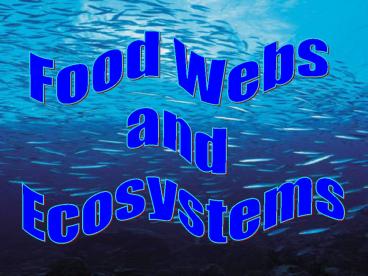Food Webs - PowerPoint PPT Presentation
1 / 18
Title:
Food Webs
Description:
All ecosystems contain many food chains. Each food chain contains both predators and prey. Ecosystems An ecosystem is a community of living organisms (plants, animals ... – PowerPoint PPT presentation
Number of Views:270
Avg rating:3.0/5.0
Title: Food Webs
1
Food Webs and Ecosystems
2
Ecosystems
- All ecosystems contain many food chains.
- Each food chain contains both predators and
prey.
3
Ecosystems
- An ecosystem is a community of living organisms
(plants, animals and microbes) in conjunction
with the nonliving components of their
environment (things like air, water and mineral
soil), interacting as a system.
4
Energy to Live
- In order for animals to live they need energy.
- Some animals get the energy they need from eating
plants and other vegetation. - Some animals get their energy from eating other
animals. - Some animals eat both plants and other animals.
5
Producers
- Nearly all food webs start with a green plant.
- Green plants are called producers because they
produce their own food.
6
Consumers
- Primary, secondary, tertiary
- Herbivore - plant eater
- Carnivore - meat eater
- Omnivore - mixed plant/animal diet
7
Herbivores
- Animals that eat ONLY plants.
- Herbivores have evolved to eat plants.
- They need a lot of energy to stay alive.
- Many have to eat all day long to get enough
energy. - They have specialized teeth and stomachs to
enable them to get the energy they need from
plants.
8
Manatee
- A manatee is a mammal that lives in the water.
- They are herbivores.
- They eat 150 pounds of plants each day!
- Manatees live in ocean waters off the coast of
Florida.
9
Carnivore
- An animal that gets its food from eating other
animals - Carnivores have evolved to eat meat.
- They have specialized teeth and stomachs to
enable them to get the energy they need from the
bodies of other animals.
10
Omnivore
- Animals that eat both plants and other animals
- Many will eat the eggs of other animals
- Omnivores have teeth and stomachs that enable
them to eat and digest both plants and meat
(animals).
11
Omnivore
- Some omnivores are scavengers which means they
eat dead animals. - Most will eat plants that produce fruit and
vegetables and will eat both the fruit and
vegetables. - Humans are omnivores
12
Food Webs
- Food webs show what eats what in order to gain
the energy it needs to live. - Food webs use arrows to show what eats what.
Eaten by
Eaten by
13
- Food chains that overlap are called FOOD WEBS.
14
Prey
- Animals that are hunted and eaten by other
animals - Some prey animals are herbivores.
- Some omnivores and carnivores are also prey to
other animals.
15
Predators
- Animals that hunt and eat other animals
- Some animals are predators and prey.
- This means they eat some animals but are eaten by
others. - The top predator that is prey to no other animal
is called an apex predator.
16
The Biotic Components of Ecosystems
- Producers(autotrophs)
- - Photosynthesis
- Consumers(heterotrophs)
- -Aerobic respiration
- Decomposers
17
Red-tailed hawk
Producer to primary consumer
Gambel's quail
Primary to secondary consumer
Yucca
Jack rabbit
Collared lizard
Secondary to higher-level consumer
All producers and consumers to decomposers
Fungi
18
Writing Activity
- Write a paragraph describing how a food web
works. Use the information you have learned in
this lesson. Be sure to tell about animals that
are both predators and prey.































